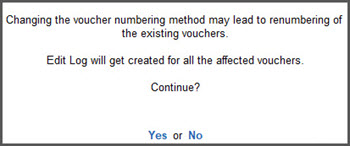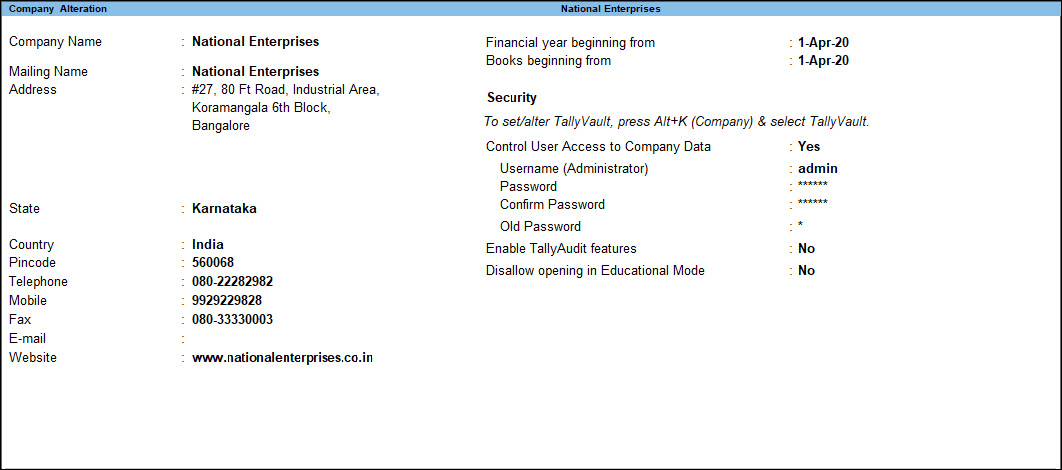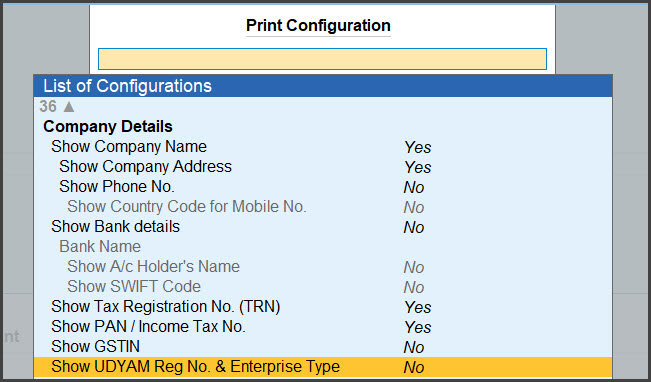Set Up Your Company
Maintaining your business transactions on a day-to-day basis is critical to your business. To keep a record of all your business transactions, you need to first create a company in TallyPrime. Through the company, you can also view and update all your transaction entries, as needed, and go through the financial reports based on the transactions that you maintain.
Once you create your company, you can set up the following:
Click to know more...Create company: To create the company, just enter the company name, address and other details, such as financial year, security, and base currency information. Once you have created your company, based on your business preferences, you can use the Company Features such as accounting, inventory, payroll, and taxation features. You can also specify the tax registration details as applicable, such as GST, VAT, Excise, TCS, or TDS, which can be accounted for your transactions.
Security: All the business transactions that you maintain in the company remain safe. You can enable additional security options for your company to prevent unauthorised access to your transaction records.
If you have more than one user accessing your company, you can set up security for each user based on their roles.
You can create an account in TallyPrime for each user. Based on the user’s roles, you can access to the tasks the user can perform.
Say you want to allow a data entry operator to make only transaction entries. You do no want this user to access your financial reports, such as Balance Sheet and P&L. However, you want the user to be able to do back-dated entries when needed. All of these can be done in TallyPrime by creating a user account for the data entry operator role and assigning the necessary rights.
Similarly, you can create more accounts if you want to maintain multiple users. See Security and User Profiles to know more about security rights and user roles.
Multiple companies: Do you have more than one business? If yes, you can create multiple companies in TallyPrime, maintain transactions separately for each business, and also manage the returns for each company accordingly.
Group company: If you are maintaining multiple companies, you can get a consolidated view of such business reports by using the Group Company feature. Viewing the financial reports separately for each business and consolidating the accounts manually can be a tedious task.
Once you have set up your company in TallyPrime based on your business requirements, you can record and manage your day-to-day transactions, and track them – even remotely.
[/expand]Create a Company to Record Business Transactions
You need to create a company to keep record of all your business transactions and view related financial reports. To create the company, just enter the company name and address and update other details, such as contact and financial year information.
In this section
Create a company
- On launching TallyPrime, select Create Company.
- If you already have one company open and would like to create another company, press Alt+K (Company) > Create.
- Provide the Company details.
- Enter the Name, Mailing name, and Address. For more information, click here.Name: Specify the company name as customers recognise your business in general. In TallyPrime, this name will appear whenever you need to select the company.
Mailing Name & Address: This name & address will be printed in all the invoices and reports. This can be the same as the company’s name. However, if you want a different name to be printed in your invoices and reports, you can specify a different Mailing Name. For example, you can have your company name as National Enterprises and the mailing name as National Enterprises Pvt Ltd, which is used in all your business communications. If you are billing from different business locations and want to have the corresponding address printed on the bills, you can add more than one address for your company. Refer to F11 Features .By default, your company data will be saved in the location specified under Company Data Path, which is the same as the folder where TallyPrime is installed. For more information on configuring your data path, refer to Manage Your Company Data.
- Enter the State, Country, and other contact details. A sample image is shown below. These details can be printed on your invoices, if needed. For more information, click here.Country and State: The Country field is prefilled depending on the country specified during installation of TallyPrime. Select the country applicable to your business and then select the State . If you do not see the State or Country that your business operates from, you can create the State or Country in the application on the fly and select the same. Ensure that your base currency is appropriate.
Telephone, Mobile, and E-mail: You can configure your bills to include these contact details and print them so that your clients can contact you when needed. You can provide your website address to have it printed on your bills. Your customers can go to your website to know about your products and services in detail.
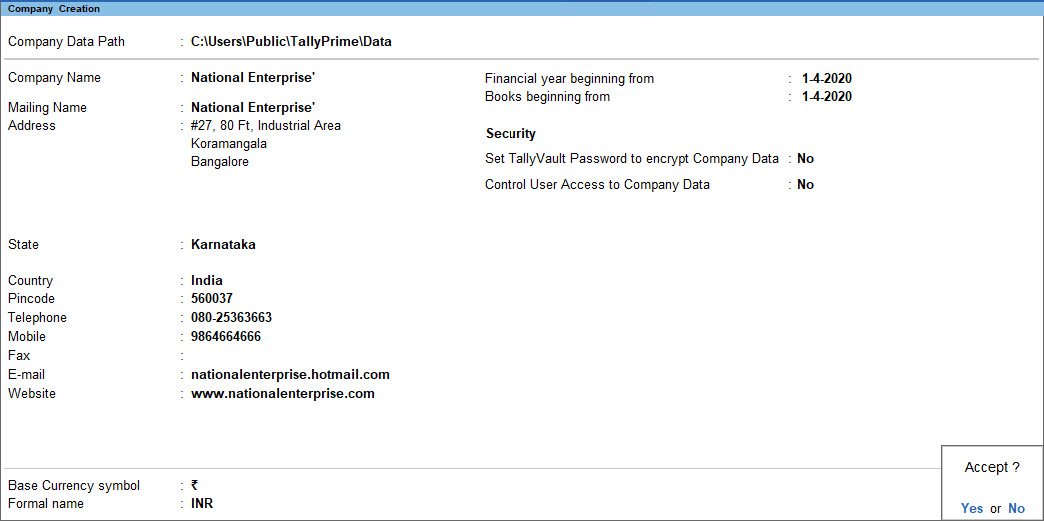
- Accept the screen. As always, you can press Ctrl+A to save the details and create the company. You can set up the remaining company details (steps 3 and 4 below) anytime later.
The name of new union territory Dadra & Nagar Haveli and Daman & Diu is provided in Release 6.6.3. All masters with Daman & Diu and Dadra & Nagar Haveli are automatically updated with the name of new union territory. The state/union territory name before merger is captured in State (before reorganisation) field. Retaining the pre-merger state/union territory name helps in managing transactions and tax returns from that period.
- Enter the Name, Mailing name, and Address. For more information, click here.
- Set up financial year details and security options.
- Financial year beginning from: TallyPrime pre-fills this field based on the date settings of your computer and the Country selected in the Company Creation screen. For more information, click here.For example, if your computer date is set to 11-03-2020 and the region is set to India, the financial year is pre-filled as 01-04-2020. If you update the company’s country as UAE in TallyPrime, keeping the computer date as is, the financial year for the company is automatically set to 01-01-2021. This is because, TallyPrime considers the computer date and the financial period applicable for the selected country and updates the Financial year beginning from field accordingly.
- Books beginning from: By default, TallyPrime fills this field with the Financial year beginning from date. You can update this, as needed. Say you started your business and have maintained all business transactions since 1-Oct-2020. You can update the Books beginning from date to 1-Oct-2020, while the financial year will be 1-Apr-2020.
- Enable Edit Log: This is optional, available from TallyPrime Release 2.1 onwards. You can enable Set Edit Log applicability under F12 and enable Edit Log for the Company. This will help you to view Edit Log for the future activities that you will perform in masters and transactions.
Furthermore, Company-level activities such as enabling or disabling the Edit Log feature, data migration, or data split that affect the Edit Log report of masters and transactions will be recorded in the Edit Log report under Company. - Security: This is optional. You can enable security features such as TallyVault and User controls for your company anytime later.
If you do not see the Security option, press F12 (Configure) > set the following options to Yes:- Use TallyVault Password to encrypt Company Data
- Use User Access Control
For more information, click here.a) TallyVault: If you do not want the company name to be displayed in TallyPrime while selecting the company, you can specify a TallyVault password for your company. This encrypts your company and therefore ensures privacy of the company data. You can access this company only if you know this password. This password cannot be retrieved, if lost. Refer to the TallyVault topic for details on managing TallyVault.
b) User Access: You can allow authorised user access to your company by setting up a username and password for the company. Which means, next time you select the company, you will need to provide this username and password to open the company data. For different users, you can set up different user credentials for controlled access of your company. Refer to the Security Controls topic for details on managing users and access rights.
- Financial year beginning from: TallyPrime pre-fills this field based on the date settings of your computer and the Country selected in the Company Creation screen. For more information, click here.
- Specify the Base Currency Information.
You can set up the base currency depending on the currency used in your business to record transactions.
To view all the options related to base currency, press F12 (Configure) > set Provide Additional Base Currency details to Yes.- If your business includes transactions in multiple currencies, refer to the Multi-currency topic.
- Accept the Company Creation screen. As always, you can press Ctrl+A to save.
Saving the company takes you to the Company Features screen, which displays that the company is created successfully.

If you have created more than one companies with the same Company Name and have loaded one company, you will not be able to open another company with a duplicate name at the same time. You will first need to close the loaded company and then load the other company.
Set up company features
As you create a company in TallyPrime, you can set up the necessary features, either now or anytime later, based on your business needs. The basic minimum key features required for you to start recording your business transactions are enabled and displayed by default. To view other features in the Company Features screen
- Set the Show more features option to Yes.
- Set the Show all features option to Yes.
| Features | Description |
| Accounting | |
| Maintain Accounts | This option is set to Yes, by default. Setting it to No will disable accounting-related options for your company. |
|
Enable Bill-wise entry |
Enable this option to display the option Maintain balances bill-by-bill created under sundry debtors and creditors. When you enter details of sales and purchases with the bill-wise option activated, TallyPrime prompts you to identify the invoice with an appropriate reference number. The reference number can then be used to allocate payments to the correct invoice to maintain an accurate account of outstanding. Bill-wise details for non-trading accounts are useful when one needs to track either an installment to be paid or a loan amount to be received over a certain period. |
|
Enable Cost Centres |
Set Show more features to Yes to view this option. Used for maintaining and allocating expenses to cost centres. |
|
Enable Interest Calculation |
Set Show more features to Yes to view this option. Enable this option to calculate interest automatically based on the interest rate and the style of calculation specified. This is useful when interest rates change from time to time. |
|
Inventory |
|
|
Maintain Inventory |
This option is set to Yes by default. This allows you to maintain your stock or inventory. Setting this to No will disable Inventory-related features for your company. |
|
Integrate Accounts with Inventory |
Set Show more features to Yes. Maintain your stock or inventory along with your books of accounts. Stock records may contain errors caused by wrong allocation to items. This feature enables finalization of financial books without waiting for the reconciliation of stocks. You can drill down from the Balance Sheet to view the Stock Register. |
|
Enable multiple Price Levels |
Set Show more features to Yes. Create multiple price levels for your stock items. |
|
Enable Batches |
Set Show more features to Yes. Maintain batch information pertaining to Stock Items. Setting this option to Yes displays the Maintain in Batches field in the Stock Item Creation screen. |
|
Maintain Expiry Date for Batches |
Set Show more features to Yes. Set expiry dates for the batches. This displays the Use Expiry Dates field in the Stock Item Creation screen. |
|
Enable Job Order Processing |
Set Show all features to Yes. Create Job Work Out or Job Work In orders. |
|
Enable Cost Tracking |
Set Show all features to Yes. Analyse and track the cost of an item in transactions. |
|
Use Discount column in invoices |
Set Show more features to Yes. |
|
Use separate Actual and Billed Quantity columns in invoices |
Set Show more features to Yes. Specify quantities that are different from those delivered/received when invoicing. |
|
Taxation |
|
|
Enable Goods and Services Tax (GST) |
If your business is under the GST regime, set this option to Yes and specify the GST Details for your company. |
|
Enable Tax Deducted at Source (TDS) |
If your business considers TDS payments, set this option to Yes and specify the TDS deductor details along with the applicable Rates and Exemptions. |
|
Enable Tax Collected at Source (TCS) |
Set Show more features to Yes. If your business considers TCS payments, set this option to Yes and specify the TCS collector details along with the applicable Rates and Exemptions. |
|
Enable Value Added Tax (VAT) |
Set Show all features to Yes. If your business is under the VAT regime, set this option to Yes and specify the VAT Details for your company. |
|
Enable Excise |
Set Show all features to Yes. Allow considering excise-related details during voucher entry. |
|
Enable Service Tax |
Set Show all features to Yes. If you pay service tax as part of your business transaction, set this option to Yes and specify the service tax details and set the preferences for your company. |
|
Online Access |
|
|
Enable Browser Access for Reports |
Set Show more features to Yes. Once your company is connected to Tally.NET server, access the key business report from the broswer in any device using your Tally.NET credentials. |
|
Enable Tally.NET Services for Remote Access & Synchronisation |
Set Show more features to Yes. Use features like Remote Access and Synchronisation. |
|
Payroll |
|
|
Maintain Payroll |
Set Show all features to Yes. Maintain payroll information in TallyPrime for the selected company. |
|
Enable Payroll Statutory |
Set Show all features to Yes. Maintain payroll-related statutory information. |
|
Others |
|
|
Enable multiple addresses |
Set Show more features to Yes. Add multiple addresses for your company, as per your business needs. |
|
Mark modified vouchers |
Set Show more features to Yes. For audit purposes, view all vouchers that are altered after creation. |
After you have created the company, in the Gateway of Tally screen, under Name of Company, the company name appears in bold.
Multiple companies: Do you have multiple businesses to track and manage? You can create as many companies in TallyPrime and manage your business transactions in each company separately. If you also prefer to get a consolidated view of the health of multiple businesses or submit summarised reports for auditing purpose, you can use the Group Company feature in TallyPrime.
Load company
Once you have created a company, you can load the company in one of the following ways:
Select company
- Open TallyPrime > Alt+F3 (Select Company) > and select the company from the List of Companies.
- If you have created more than one company, you can browse to the data path and select the required company to open.
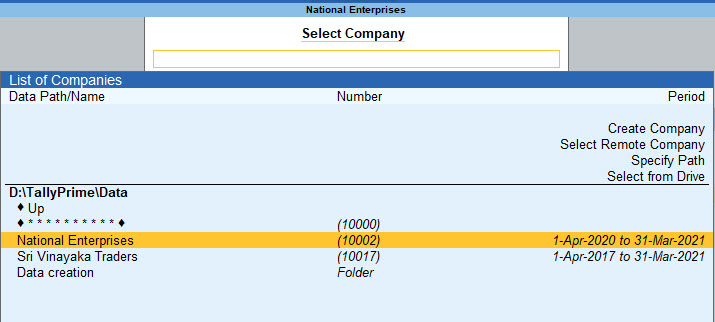
Not able to load the company? Refer to MAV issue while loading company.
Load company on startup
If you wish to load one or more companies by default, whenever you open TallyPrime, you can configure the same.
- Open the Startup Settings screen: Press F1 (Help) > Settings > Startup.
- Set the option Load companies on startup to Yes, and press Enter on Companies to load.
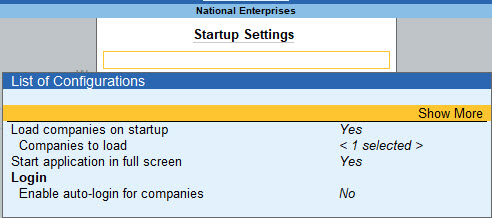
- In the List of Companies to Load on Startup screen, select one or more companies, based on your need.
- Select End of List, after your have selected the companies to be loaded on startup.
The companies that you select here will be loaded by default next time you open TallyPrime.
Update Company Details | Alter Company
If your company address, phone number, or any other contact information was not provided earlier or has changed, you can update such details in TallyPrime. Any changes made to these details will be reflected accordingly in your reports and printed invoices.
- Press Alt+K (Company) > Alter.
- In the Company Alteration screen, make the necessary changes.
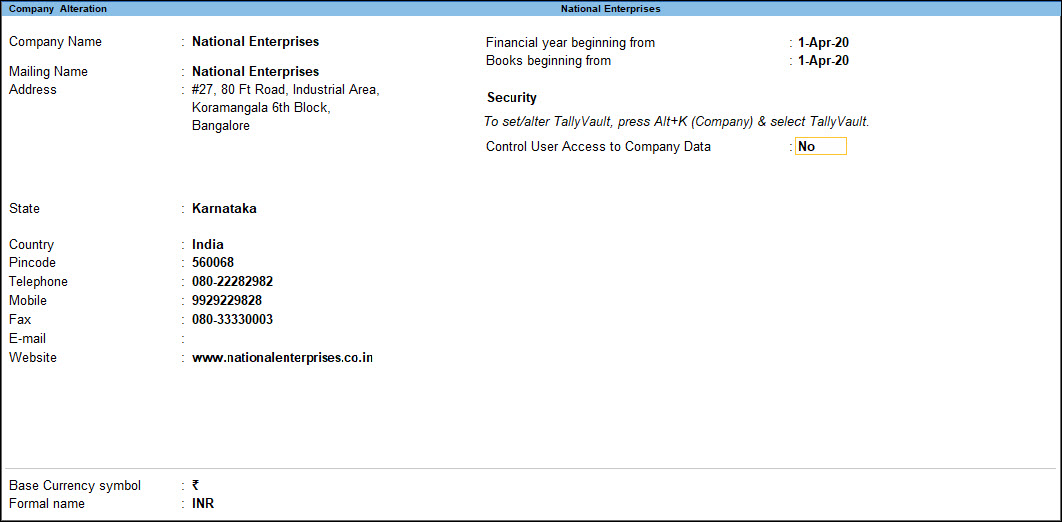
- Accept the screen. As always, you can press Ctrl+A to save.
If you do not need the company anymore, you can delete the company as well.
- Press Alt+K (Company) > Alter.
- In the Company Alteration screen, press Alt+D. The company will be deleted permanently.
If you want to access the business transactions recorded in the company at a later time, you can take a backup of the company before you delete it. Note that once you delete the company, you cannot retrieve it, and therefore keeping a back up of the company data is recommended.
Allow Back-Dated Transaction Entries | Update Financial Year
If you have maintained your books of accounts prior to the current financial year, you can add all of the back-dated transactions to your company in TallyPrime. Let us assume that you started your business in 1-Jun-2019 and have maintained your business transactions since then. However, you created a company in TallyPrime on 1-May-2019. By default, the books and financial years in TallyPrime are both set to 1-Apr-2020.
To allow entries of transactions in TallyPrime starting 1-Jun-2019, you will need to update the financial year information of the company.
- Press Alt+K (Company) > Alter.
- In the Company Alteration screen, update the Financial year beginning from as 1-Apr-2019 and the Books beginning from date as 1-Jun-2019.

- Accept the screen. As always, you can press Ctrl+A to save.
You can change the Books beginning date in the Company Alteration screen anytime to make back-dated entries up to 1-Apr-2019 for the financial year 2019-2020.
For more information, click here.
Edit Log in TallyPrime Release 2.1
TallyPrime Release 2.1 onwards, you have a facility to view Edit Log of transactions and masters including ledgers, groups, and stock items.
In this section
- Enable Edit Log while altering company
- Disable Edit Log while altering company
- Activities affecting Edit Log
Enable Edit Log while altering company
To enable the feature from the Company Alteration screen:
- Press Alt+K (Company) > Alter.
- Enable the Edit Log feature.
- Enable Edit Log: Yes.
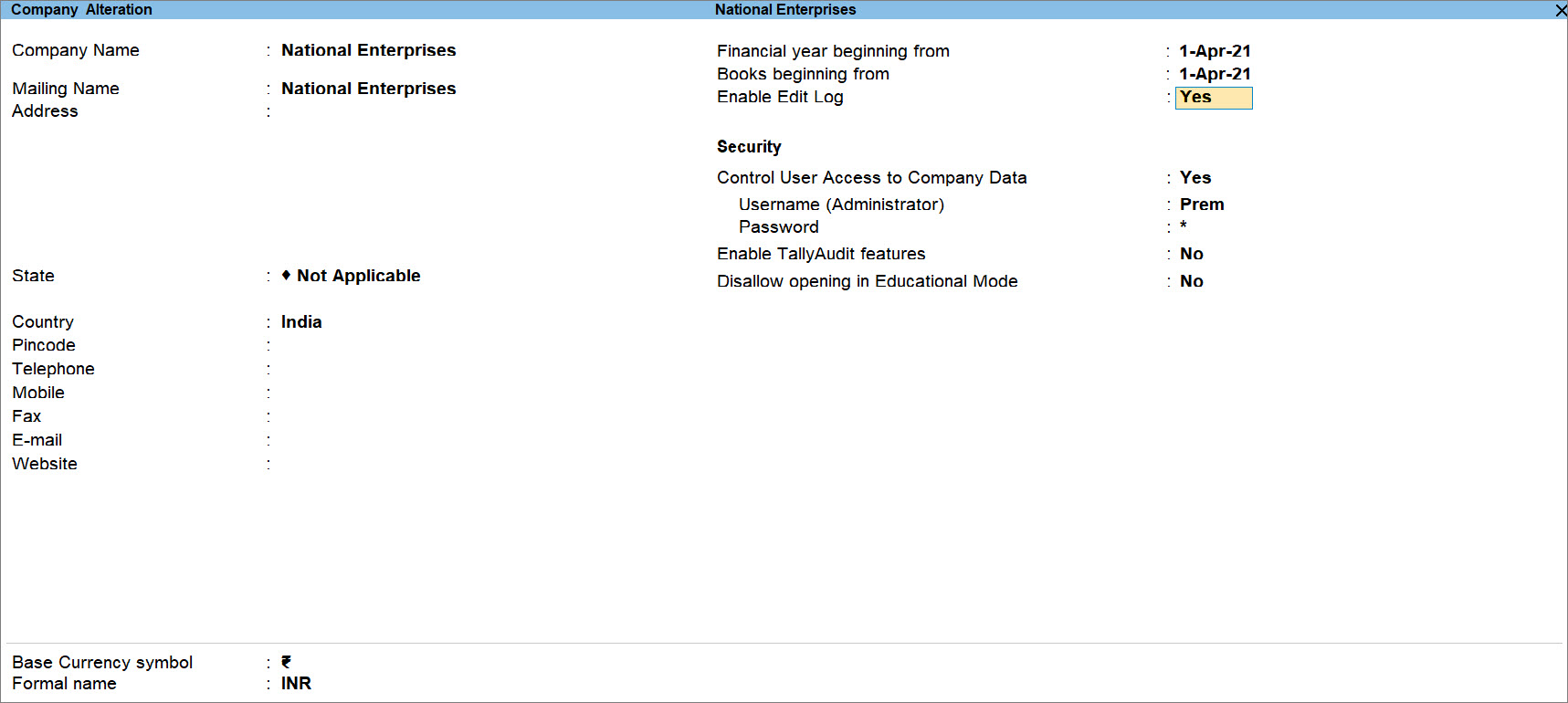
If you do not see the option, then press F12 (Configure) > Set Edit Log applicability: Yes.

This option is not for enabling or disabling the feature. This action is performed only to display the option to enable or disable in the Company Alteration screen.
Once you enable Edit Log, you will get the message as shown below.
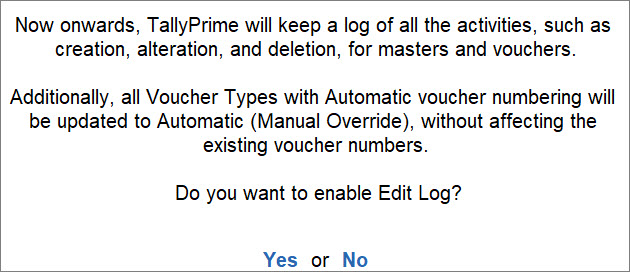
This message occurs because enabling Edit Log impacts the activities regarding masters and transactions. Furthermore, after enabling, any activity, such as creating, altering, or deleting masters or transactions, will lead to the creation of logs in the respective masters and transactions.
- Press Y to save the setting.
- Enable Edit Log: Yes.
- Press Ctrl+A to accept the configuration.
- Press Ctrl+A to save the settings in Company Alteration screen.
Henceforth, edit log will be created for all the activities performed in transactions, ledgers, groups, and stock items.
Disable Edit Log while altering company
You can disable Edit Log from the Company Alteration screen at any point in time.
- Enable Edit Log: No.
You will get the message as shown below.

This message occurs because disabling Edit Log will stop TallyPrime from tracking the activities related to masters and transactions in TallyPrime. As a result, you will not be able to view Edit Log unless you enable the feature again. However, you can view the already recorded edit logs for transactions and masters when you enable the Edit Log feature again. This is because the logs recorded when the Edit Log feature was enabled are retained in TallyPrime. - Press Y to disable.
Activities affecting Edit Log
The activities such as enabling or disabling the Edit Log feature, data migration, data split, and other activities at the Company-level impact the Edit Log for transactions and masters. The Activities Affecting Edit Log report under Company keeps you updated about activities that affect Edit Log of transactions and masters.
It is important to know that this is not an Edit Log report for the Company but it captures only the activities that can affect the Edit Log of transactions and masters.
- Press Alt+K (Company) > Edit Log.

If there are multiple companies loaded in TallyPrime, then the List of Companies screen appears.
Select the Company for which you want to view the Activities Affecting Edit Log report.
To know more about the nature of activities that the Company’s Edit Log lists, refer to Activities under Edit Log for company.
Activities captured in the report
| TallyPrime Edit Log | TallyPrime |
|---|---|
|
|
If the Security Control is not enabled in your Company, then the activities will be logged with username as Unknown (Security not enabled).
Activities in Edit Log report for transactions and masters
| Nature of Activity | Activity Label in Edit Log |
| Creation |
|
| Alteration |
|
| Deletion |
|
| Resave |
|
| Previous Record |
You may make a lot of changes in a transaction or a master when Edit Log is disabled in the Company. Previous Record refers to the consolidated data of the activities performed in TallyPrime when the Edit Log is disabled or in a migrated Company data where Edit Log was not enabled. The activity called Previous Record gets logged in transactions and masters when they are altered, resaved, deleted for the first time after:
Previous Record:
Note: When you perform the first activity in the imported transaction or master, two activities will get logged.
|
| Activities with Status: Optional and Status: Cancelled |
There can be activities such as creation, resaving, or alteration with Status: Optional and Status: Cancelled. The statuses are provided for such vouchers because these transactions do not affect your financial reports, until they are made regular. |
| Method of voucher numbering |
In TallyPrime Edit Log and TallyPrime Release 3.0 with Edit Log enabled, whenever you change the Method of voucher numbering, TallyPrime displays a message. When the method of voucher number is changed, there is a possibility that some vouchers will get renumbered. So, the Vch. No. in those transactions gets altered, which leads to the creation of an Edit Log for those vouchers. Note: You need to consider the impact on taxation and compliance, if any, before changing a voucher numbering method. If the number of vouchers are too many, TallyPrime will take some time to renumber all vouchers. Moreover, you will get the same message as above, if you enable Set/Alter additional numbering details to Yes and change the voucher type configurations. |
If the Security Control is not enabled in your Company, then the activities will be logged with username as Unknown (Security not enabled).
Differences Between Edit Log Versions
When you drill down on a version in the Edit Log report for any transaction or master, you can view the differences between the selected version and the immediate previous version.
TallyPrime Release 6.0 onwards, you can also view the changes made in Bank Date, Instrument Number, and Instrument Date. Moreover, you will also get to know if a UPI is changed.
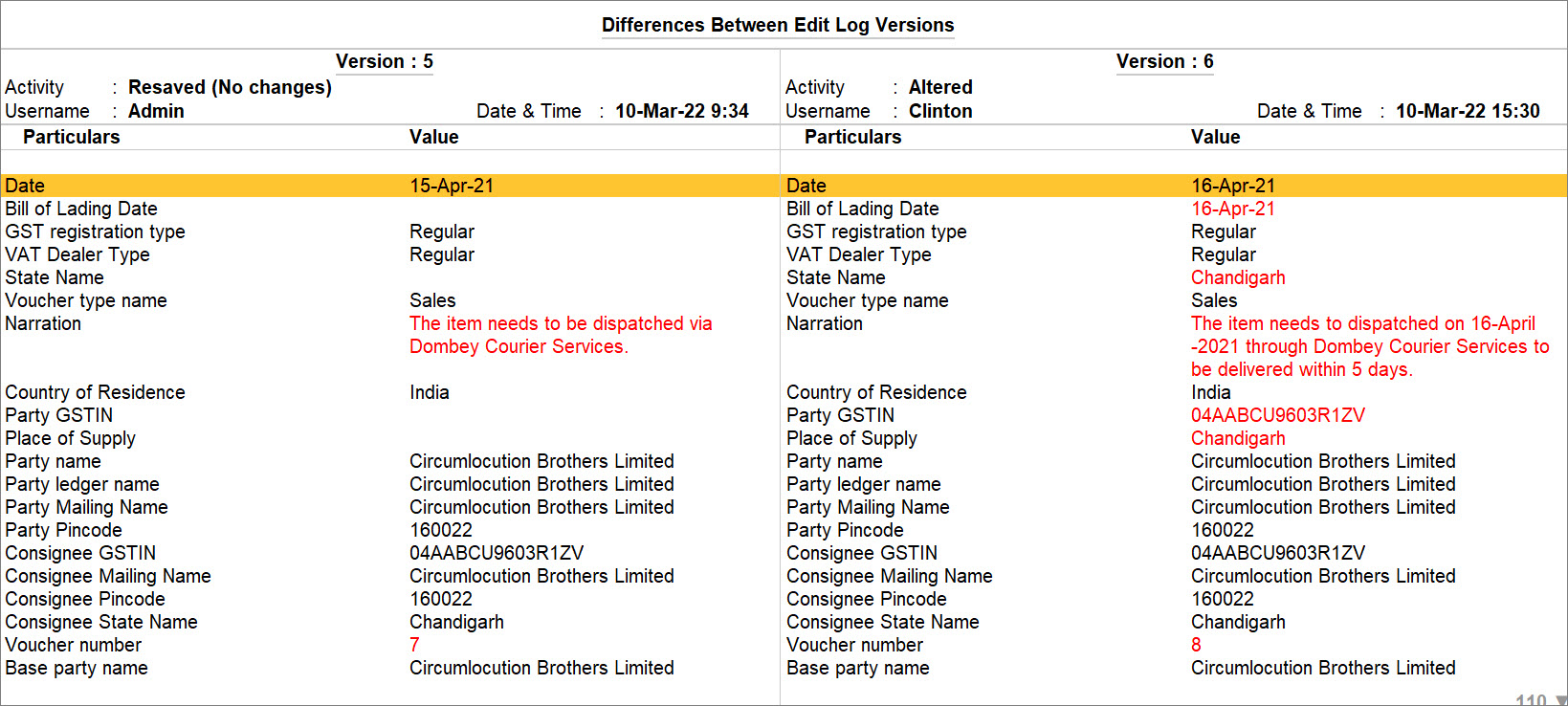
The values in the reports are organised based on the fields and their hierarchy.
The field values that have changes between the versions are marked in red, regardless of the users changing the values or internal changes.
Keys for specific actions in the report
| Keys/Action | Result |
|---|---|
| +/– | Move between the next and previous versions |
|
PgDn/PgUp |
Scroll within the report |
| Shift+F5 | View the details of the changes |
|
Shift+Enter/Enter/double-click |
Explode a line |
| F12 |
Configure the report |
A few special cases of the diff report
Activity: Created
The version on the left-hand side is empty and no field value is shown in red.
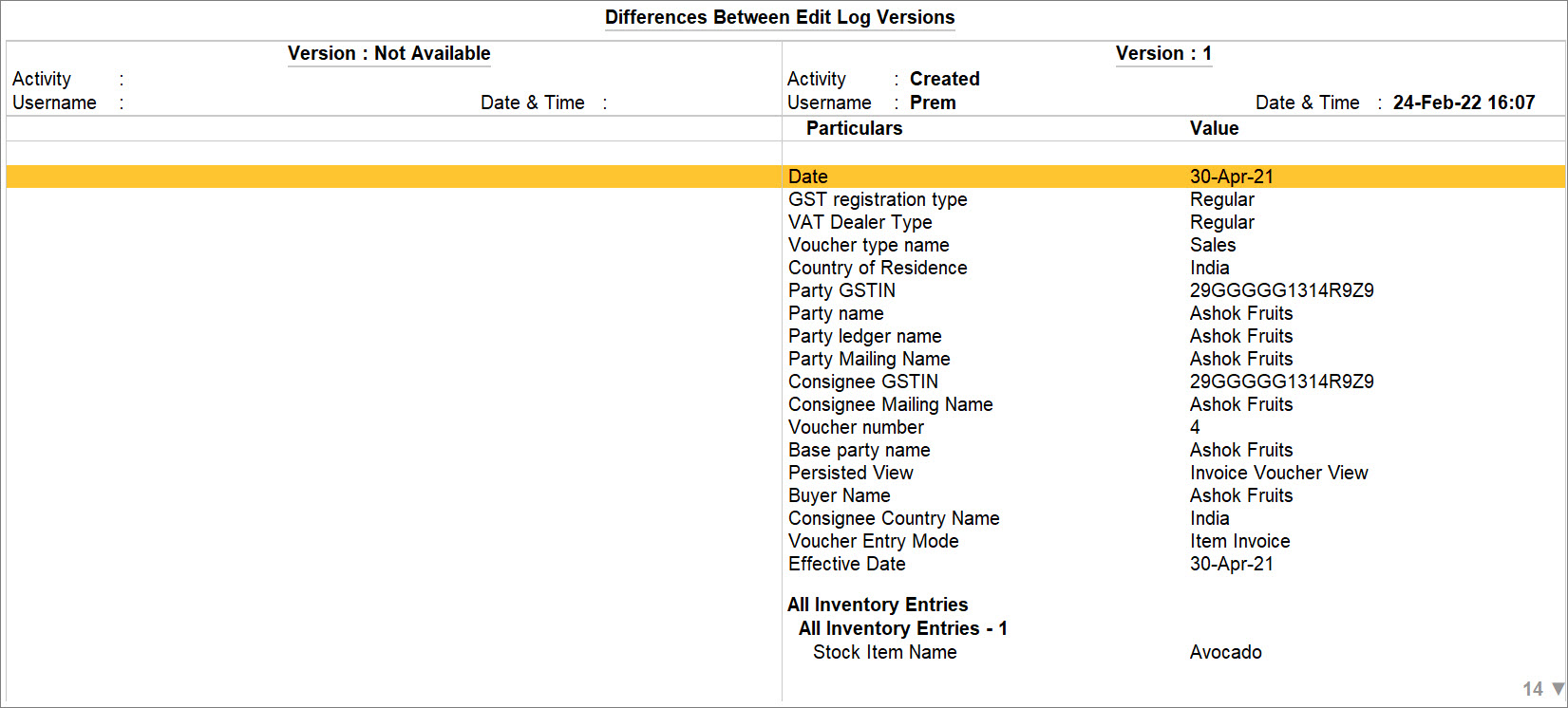
Activity: Deleted
The version on the right-hand side is empty and no field value is shown in red.

Activity: Resaved (No changes)
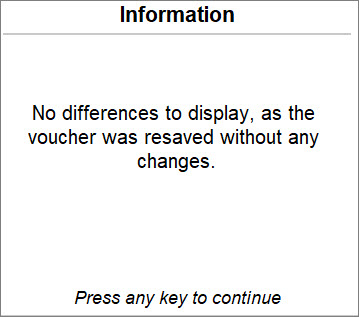
Other cases in Differences Between Edit Log Versions report
| Type | Action/Reason | Impact |
|---|---|---|
| User action | Voucher Type changed during alteration | Order of fields in the Differences Between Edit Log Versions report will change. |
| Change in order of ledgers | Order of ledgers in the Differences Between Edit Log Versions report will change. | |
| Altered ledgers and then altered vouchers | Changes due to ledger alteration will be shown in the report for the transaction in which the ledger is used. For example, if you change the address in a particular party ledger and then alter a transaction with the ledger, then the values affected due to ledger alteration will start appearing in the Differences Between Edit Log Versions report of the transaction. | |
| Changed the number of decimal places for units | Field values get marked in red, even when the value remains the same. This happens because even if you set the number of decimal places to 2, TallyPrime internally calculates the values with 4 decimal places. | |
| Configuration-based values | Occurrence of disabled field in report | Regardless of enabling or disabling certain features, values related to such features will appear with appropriate default values. For example, even if you have not enabled GST or VAT, then also you will see fields related to GST or VAT. This happens because, irrespective of the status of the feature – enabled or disabled, transactions and masters have those values as a part of the data. |
| Use of TDLs | Display of User-Defined Fields | If there is any TDL that modifies the field labels and the TDL is not present when loading the report, then the values will be shown without labels. |
| Data behaviour | Values that are only shown in the voucher but not part of the data | A few fields such as discount percentage and alternate units shown on the voucher for reference are not included in the report. |
| Nature of Data | Data presentation in the report | The way you see data in the report may change from the way you see in the voucher or master screen. This happens because the way data stored in TallyPrime differs from the way it is presented. |
Set Up User Access Control | Set/Remove Security Settings
Security of business transactions and financial reports is critical, especially to avoid misuse or unauthorised access. TallyPrime helps you set up security for your company and change the credentials when required. Based on your business practice, you can enable the security feature by altering the company in TallyPrime.
In this section
Control user access to Company data
- Press Alt+K (Company) > Alter.
- Enter security details:
- Set Control User Access to Company Data to Yes.
If you do not see this option, press F12 (Configure) > set Use User Access Control to Yes. - Provide the Username (Administrator) and Password. The credentials you specify here must be entered every time you open your company.

As you press Enter, the following warning message appears:
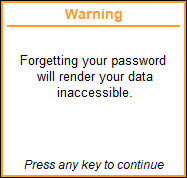
- Set Control User Access to Company Data to Yes.
- Accept the changes. As always, you can press Ctrl+A to save.
- Use TallyAudit features: TallyAudit allows the administrator or an auditor profile user to track changes in the accounting information.
- Disallow opening in educational mode: Set this option to Yes, if you do not want the company to be opened in the educational mode. In the educational mode, you can record transactions only on the first and last day of a month.
- On accepting the company creation screen, if you have specified TallyVault password, TallyPrime prompts you to enter the user name and password.
On accepting the company creation screen, if you have specified TallyVault password, TallyPrime prompts you to enter the user name and password.
Alter security
Once you have saved the company, you can alter the credentials anytime later, from:
- Company alteration screen
- Users and Passwords menu
To alter security from the company alteration screen:
- Press Alt+K (Company) > Alter.
- Select the company, if multiple companies are loaded.
- You can change the administrator name, password, or both.
- To alter only the name of administrator:
- Security > enter a new Username (Administrator).
- Enter the existing password in all the password fields.
- To alter only the password:
- Security Control > enter the existing Username (Administrator).
- Enter a new Password, and repeat it in the Repeat Password field.
- Enter the Old Password.
- To alter both the administrator name and the password
- Enter a new Username (Administrator) and a new Password.
- Enter the Old Password.
- To alter only the name of administrator:
To alter security from the User and Passwords menu
- Press Alt+K (Company) > select Change User.
- Change the username or password.
- Change User: Select Change Username and provide a different username.
- Change Password:
- Enter the Old Password.
- Enter a New Password, and repeat it in the Confirm New Password field.
When altering security setting, providing the old password ensures that an authorised user is attempting to alter the credentials of the company.
When altering security setting, providing the old password ensures that an authorised user is attempting to alter the credentials of the company.
Remove security control
- Press Alt+K (Company) > Alter.
- Set Control User Access to Company Data to No.
- Enter the existing password in the Current/Existing Password field.
- Accept the changes. As always, you can press Ctrl+A to save.
TallyVault
Based on your business environment, if you want to maintain privacy of the company that you have created in TallyPrime, use TallyVault. Providing a TallyVault password encrypts your company and all the transaction details, including the company name. Next time you open your company, you will need to first enter this password to view the company name and other details.
TallyVault is an enhanced security system that allows encryption of your company data. Encryption involves converting normally accessible Tally information into unrecognizable information, which can only be reconverted by authorised persons.
You can set a TallyVault password:
- On the Company Creation screen, while creating the company in TallyPrime.
- (If you had already created a company without a TallyVault password) By selecting the TallyVault option from the Company menu: Alt+K (Company) > TallyVault.
You can also alter the TallyVault password from the same screen.
For more information, refer to TallyVault under Access Control and Security.
If you have specified credentials for security control and the TallyVault password, next time you open the company, you will need to first enter the TallyVault Password and then the security credentials.
Use Currency as Applicable for Transactions | Set Up Base Currency
Currency details for your company are pre-filled based on the country that you have selected during company creation. If your business is set up in India, the base currency is by default set to Rupees. All the transactions that you record and the reports that you view in TallyPrime will show the values in the base currency that is set for your company. If your business is set up in India but you have customers from a different country, you can specify the base currency as applicable for that country.
- Press Alt+K (Company) > Alter.
- Base Currency Symbol: For example, ₹ for Rupee, AED for United Arab Emirates Dirham, and so on.
- Based on the currency you choose, you can update the remaining options applicable to that currency. For example, if you have chosen Rupee as the base currency:
- Update the Formal name to INR.
- Set Suffix symbol to amount to No, because the ₹ always appears before the number (for example, ₹5000).
From TallyPrime Release 7.0, you can now use the official currency symbols for UAE (Dirham) and KSA (Saudi Riyal).
To know the shortcut to add the new symbol, refer to Keyboard Shortcut.
- Based on the currency you choose, you can update the remaining options applicable to that currency. For example, if you have chosen Rupee as the base currency:
- Similarly, update the other options as applicable for the currency chosen.

- Accept the screen. As always, you can press Ctrl+A to save.
For more information, click here. Multi-currency As an MSME business, you must have received an UDYAM number at the time of registration with the department under the MSMED Act. You can record or update the UDYAM registration number in TallyPrime and print the same in your business documents such as orders, invoices, bills, reminder letters and so on. This will help inform the buyers about the business’s MSME status and assist in receivng on-time payments. The format of the UDYAM Registration number is as follows UDYAM-SS-XX-YYYYYYY. UDYAM is followed by a two-digit state code, then two digits, and lastly a seven-digit code. In case you want to update your UDYAM Registration number: By Printing the UDYAM details in documents such as invoice, orders and reports, MSMEs can inform all the buyers (companies taking their supplies, services, and so on) about their MSME status. This wll help buyers recognise invoices as MSME payments and clear them within an agreed date. In order to receive timely payments MSMEs should identify the outstanding bills approaching due date/overdue and send reminder e-mail to the buyers for payment settlement. The report shows the bills based on the selection in Basis of value. In case you had selected Bills Due in Upcoming Days and set the number of days as 20, the bills that are due in the next 10 days and the overdue bills are shown. By default the report displays the Due on date for all the bills. You can change this to days until due date, overdue days, and overdue days from bill date. Configuration You can add further details to the report using the configuration options.
If your business has customers in more than one country or you need to maintain transactions in different currencies, you can use multiple currencies in TallyPrime. For more information, refer to the Multi-currency topic.Setup/Update UDYAM Registration details for MSME Companies
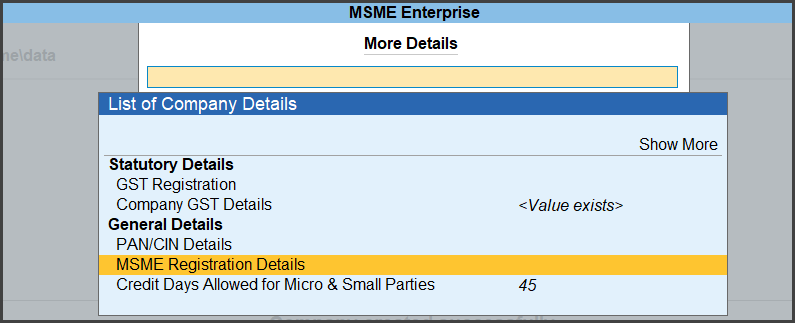
In the MSME Registration Details sub-form,


In the MSME Registration Details sub-form,
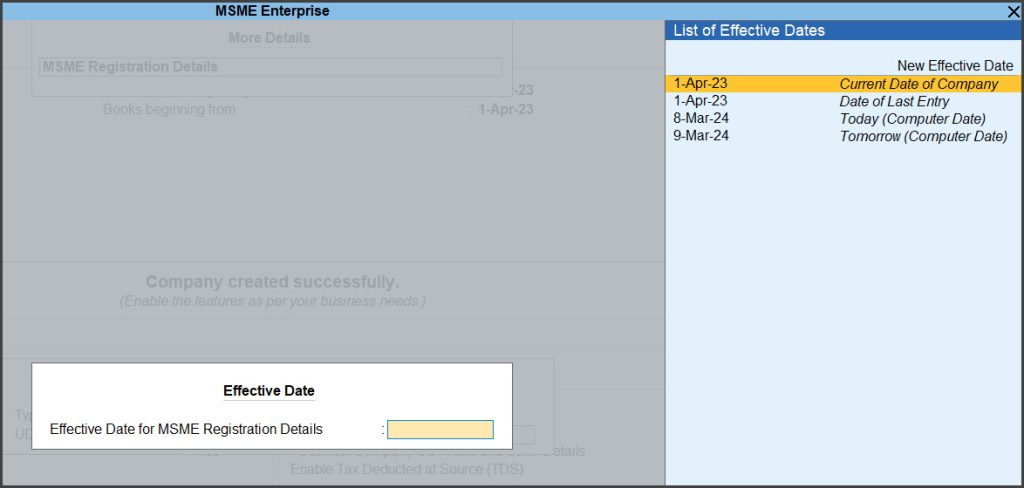
Press Enter.Check History of UDYAM Details
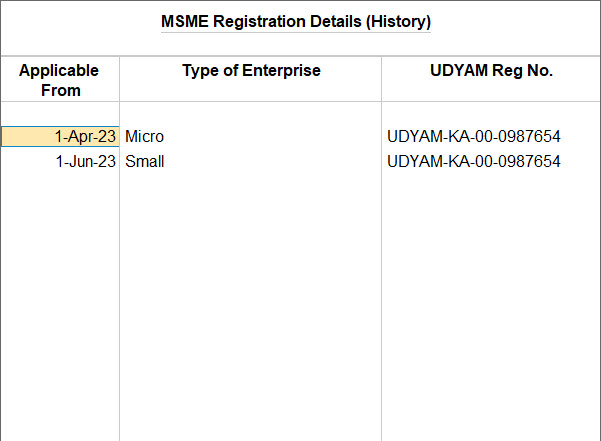
Print UDYAM Details in Documents
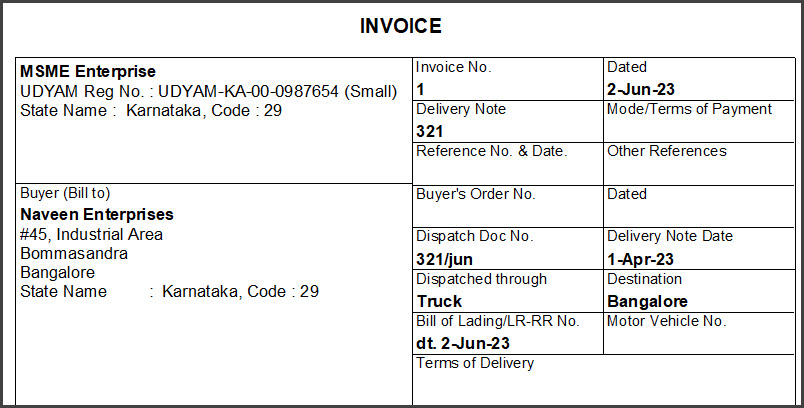
Check Upcoming Due Dates for Receivables
Alternatively, Gateway of Tally > Display More Reports > Statement of Accounts > Outstandings > Receivables.





